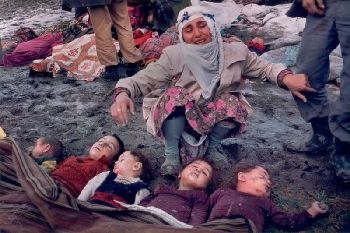
Publisher:
Bonnie King
CONTACT:
Newsroom@Salem-news.com
Advertising:
Adsales@Salem-news.com

~Truth~
~Justice~
~Peace~
TJP
Sep-16-2009 00:44

 TweetFollow @OregonNews
TweetFollow @OregonNews
AMP Commemorates Sabra and Shatila Massacre
Salem-News.comToday, 27 years later, Israeli aggression against Palestinians continues.
 The scars left by the Sabra and Shatila massacres are indescribable. Photo courtesy: Piotr_360 |
(PALOS HILLS, Ill.) - Palestinians and their supporters will commemorate the 27th anniversary of the Sabra and Shatila massacre, one of the worst tragedies in Palestinian history.
On Sept. 16, 1982, members of the Lebanese Christian Phalange militia – with direct approval and support of then-Israeli Defense Minister Ariel Sharon – entered Sabra and Shatila and initiated a 36-hourlong assault, which resulted in the deaths of thousands of unarmed Palestinian and Lebanese civilians.
Journalist Robert Fisk, who was on the scene on September 19, 1982, reported seeing the “blackened bodies of babies tossed into rubbish heaps alongside discarded U.S. army ration tins, Israeli army equipment and empty bottles of whiskey.”
The infants had been shot in the head. Some had had their throats slit. Scores of men had been shot in the back of the head or mutilated by axes. Women had been raped. Pregnant women had fetuses torn from their bodies.
The United Nations, which issued a formal declaration of genocide in 1982, also calls the Sabra and Shatila massacre one of the most heinous events in the 20th century.
How many died is not known, but figures range from about 1,000 to at least 3,500, a number estimated by the late Israeli journalist Amnon Kapeliouk.
“The exact figure (of victims) can never be determined because, in addition to the approximately 1,000 people who were buried in communal graves by the International Committee of the Red Cross or in the cemeteries of Beirut by members of their families, a large number of corpses were buried beneath bulldozed buildings by the militia members themselves,” wrote Dr. Laurie King-Irani, an adjunct professor of anthropology at the Center for Contemporary Arab Studies at Georgetown University. “Also, particularly on 17 and 18 September, hundreds of people were carried away alive in trucks towards unknown destinations, never to return.”
Dr. King-Irani also was the North American Coordinator of the International Campaign for Justice for the Victims of Sabra and Shatila, which hosted the Web site indictsharon.net.
Yet the perpetrators of the massacre were never brought to justice. An internal Israeli investigation called the Kahan Commission – which was political and not judicial – found Sharon to be indirectly but personally responsible. He resigned as defense minister but retained a government cabinet position. He served as prime minister from 2001 to 2006. A case that had been filed in November 2001 on behalf of some survivors against Sharon and others for committing war crimes under Belgium’s universal jurisdiction law was later rejected by a Belgian appeals court.
Sharon told the Israeli Knesset that the decision to send in the Phalangists had been made at 3:30 p.m. on Sept. 15. The Israeli Command received the instructions that the “mopping up of the camps will be carried out by the Phalanges or the Lebanese army,” Dr. King-Irani writes, citing the Kahan Commission report, page 125.
Today, 27 years later, Israeli aggression against Palestinians continues. Operation Cast Lead in December and January killed more than 1,400 Palestinians in Gaza and wounded more than 5,300. Israel’s continuing siege has squeezed the 1.5 million residents there into an inhumane and unthinkable crisis.
The American Muslims for Palestine (AMP) today honors the victims and survivors of Sabra and Shatila by keeping their memories alive. Where their voices have been silenced, we must raise our voices loudly and clearly and call for an end to the brutal occupation of Palestine and for the right of refugees to return to their homeland.
For articles and videos on the Sabra and Shatila massacre, go to ampalestine.org.
The American Muslims for Palestine is a national, grassroots organization, whose mission is to educate the American public about issues pertaining to Palestine and its rich cultural heritage. For more information, contact Kristin Szremski, director of media and communications, American Muslims for Palestine, 10101 S. Roberts Road, Suite 102, Palos Hills, IL 60467. 708.717.4180 cell; 708.598.4267 office.
Articles for September 15, 2009 | Articles for September 16, 2009 | Articles for September 17, 2009

Quick Links
DINING
Willamette UniversityGoudy Commons Cafe
Dine on the Queen
Willamette Queen Sternwheeler
MUST SEE SALEM
Oregon Capitol ToursCapitol History Gateway
Willamette River Ride
Willamette Queen Sternwheeler
Historic Home Tours:
Deepwood Museum
The Bush House
Gaiety Hollow Garden
AUCTIONS - APPRAISALS
Auction Masters & AppraisalsCONSTRUCTION SERVICES
Roofing and ContractingSheridan, Ore.
ONLINE SHOPPING
Special Occasion DressesAdvertise with Salem-News
Contact:AdSales@Salem-News.com

googlec507860f6901db00.html

Salem-News.com:
Terms of Service | Privacy Policy
All comments and messages are approved by people and self promotional links or unacceptable comments are denied.
Tony September 15, 2010 2:17 am (Pacific time)
Actually, this is not a picture from Sabra and Shatila. This pic is in winter and the massacre was committed in summertime. This pic is typical of a Kurdish village
Editor: I think it is Sabra and Shatila, either way it represents the same image of precious lives snuffed out, only so many photos of the victims at Shabra and Shatila do look far worse. You know that Israel watched over that operation, right? You know it followed Israel's murder of thousands of Palestinians? Do you know when it happened? Have you ever placed it on a timeline with events that involve the US? Hmmm, leaves you plenty to think about I would say. Here is a great quick YouTube video that tells the story of Sabra and Shatila: Palestinian Massacre at Sabra and Shatila - IfAmericansKnew
[Return to Top]©2025 Salem-News.com. All opinions expressed in this article are those of the author and do not necessarily reflect those of Salem-News.com.